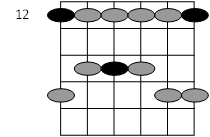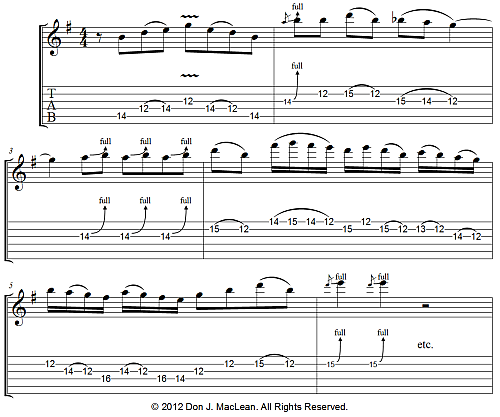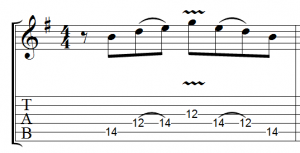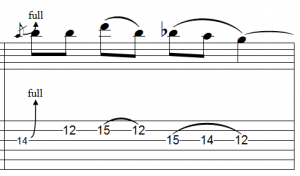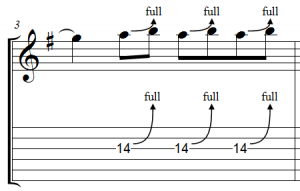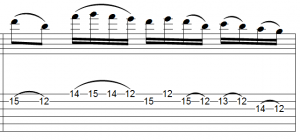Creating your own guitar solos is tons of fun and can become extremely addicting.
For many beginning improvisers though, going from a scale fingering to a full-blown guitar solo seems like a mysterious, confusing and daunting task.
In this article we are going to remove some of this mystery. But before we get started, we need to clear something up…
It’s important that you know that there is no simple magic technique that will turn you into the greatest guitar soloist on the planet overnight. The good news is that there are many techniques that can turn you into a good soloist and possibly even a great one—it just won’t happen overnight.
Learning to create your own guitar solos does take some time and effort, but boy is it ever worth it.
Learn to Imitate Before You Originate
If you decided that you wanted to be the greatest English language novelist on the planet, but you didn’t speak a word of English and had never read a book…
Well you probably know where I’m going with this. What’s that expression about a snowball in a warm place?
Obviously, as a bare minimum, to write a great novel you need to understand the language, and what makes for a good novel.
It’s not really that much different in music.
Music is a language of its own. To create a guitar solo it’s best to know what guitar solos you like and to take it a bit deeper and understand what specifically it is that you like in those guitar solos.
This is why it’s always a great idea to learn to play many of your favourite guitar solos, and most importantly, to take that a step further.
Sound good?
I’m sure you don’t need me to twist your arm to learn guitar solos! After all, that’s probably the reason you decided to get started on guitar in the first place. But instead of mindlessly learning guitar solos, we will do something very important.
Start by learning from the pros. Learn what your favourite guitar players do.
How do you go about doing that?
Fortunately, it easier today than it has ever been. There are lots of great song transcriptions to choose from. Just be sure you get the right transcription or you could end up wasting a lot of time learning something wrong.
Get one or more of the professionally transcribed guitar solos for songs that you really want to learn and then learn to play them note-for-note.
I say professionally transcribed instead of the free tab, mainly because a lot of the free tab is wrong. Remember just about anyone can put up and website or post tab online, that guitar solo you are about to learn could have been posted by somebody that just started to play guitar! If you are not sure what to look for in guitar sheet music and tab, you’ll want to read this article: How to Buy Guitar Sheet Music, Songbooks, or Tab and Not Get Ripped Off and then come back here.
Next comes the fun part…learn the song.
But here is the key part…
As you work on the guitar solo, see if you can determine what scales are used. Now depending on the transcription, this might be really easy. The good song books and guitar magazines will often have a section that explains what guitar scales are being used. Once you’ve identified the scales being used in the guitar solo, it’s time to play those scales.
So for example, if the guitar solo uses E minor pentatonic, E blues and E natural minor scales, play these scales ascending and descending. Then compare the scale fingerings to the guitar solo. See how the guitar solo is built from these scale fingerings.
E Minor Pentatonic
E Blues Scale
E Natural Minor
Now do understand that I’ve only shown one of the many ways to play each of the above scales. There are many different ways to play the same scale on the fretboard. On top of that, most pros will use different variations of scale fingerings for melodic interest and contrast. As you begin to master these different fingerings you will open up many new options for your guitar solos.
To illustrate how this works, let’s take a look at an example.
Below you will see a six measure example of a middle of the road rock guitar solo. There are some string bends, vibrato, hammer-ons and pull-offs, and even a small arpeggio.
Now let’s take it apart.
In measure 1, the E minor pentatonic scale is used.
Here is the scale fingering, this time in tab and standard notation.
Play the scale fingering forwards and backwards at least five times to establish the sound of the scale in your head and also to start to get familiar with the fingering.
Then play the first measure. Can you see and hear how these notes come directly from the E minor pentatonic scale? To make this even clearer, you will see the notes highlighted below.
So in measure 1, as you can see, just a tiny portion of the E minor pentatonic scale fingering is used.
Now let’s look at measure 2.
Measure 2 uses the E blues scale. Here is the scale fingering…
Play the scale fingering forwards and backwards at least five times to get the sound of the scale in your head. This will also get you started on learning the scale fingering. Then, take a look at measure 2 again. Can you see how this scale fits the E blues scale fingering shown above?
Measure 3 returns to the E minor pentatonic scale.
So once again play the scale fingering and then the excerpt from the solo.
Measures 4-6 use the E natural minor scale (E Aeolian).
Measure 4
Measures 5-6
Here is a fingering for the E natural minor scale.
Now, depending on your skill level and knowledge of guitar music theory, this will either be super easy or challenging. If you’re not very familiar with music theory don’t worry. It’s actually not as hard as you probably think it is—if you learn it the right way.
Now of course, many guitar solos won’t fit as nicely as this all of the time. Most guitar solos use multiple scale fingerings and often span large portions of the fretboard. The main point I want to demonstrate in this article, is how guitar solos really just come from scale fingerings. When you know the most common guitar scale fingerings, you will learn your favourite guitar solos faster. You’ll also be able to see how your favourite guitar solos come straight out of standard scale fingerings. When you know your scale fingerings, you’ll have all the notes you need to create your own guitar solos.
If you are ready to understand how scales really work on the guitar, you’ll want to check out one of my books called – The World of Scales: A Compendium of Scales for the Modern Guitar Player. You can learn more about it here:

